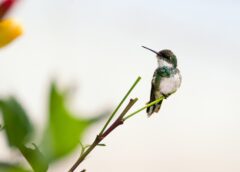As the days grow shorter and cooler, I have pondered whether or not it is time to take down our hummingbird feeder. As far as timing, I know that some hummingbirds start migrating as early as mid-July and others wait until August or September. But I wonder if these tiny, energetic birds have all left for the winter or if there might be a few stragglers still hanging around.
It turns out most hummingbirds do, in fact, migrate. There is even one species of hummingbird (the rufous) that makes the longest migration compared to its size of any bird on earth, traveling from Alaska to Mexico! Most make their way to sunnier climates in the Caribbean, Central America, Mexico, and even South America. However, there are some that do not. And if they do not, they definitely need a place to stop and feed.
Hummingbirds have the highest metabolism of any endothermic animal on earth. Endothermic refers to the fact that hummingbirds, like humans, must generate their own body heat to keep warm. While a high metabolism means that they require a tremendous amount of calories to sustain themselves to live to fly another day. In addition to feeding on tree sap and nectar for calories, hummingbirds are carnivores and feast on insects and spiders which cannot typically survive in wintery temperatures. The sugary water that we put out for them and the flower nectar they feed on is merely fuel for their insect and spider hunting pursuits. Needless to say, flowers that produce life-giving nectar are also not generally available in cooler temperatures.
But, times they are a changing! And our environment is changing as well! Climate change has ushered in an alteration to ecosystems. Milder temperatures in some areas allow for flowers to bloom year-round and insects to breed year-round as well. Hummingbird feeders are also being left out longer and throughout the year as well which contributes to the hummingbird’s food supply and ability to sustain itself.
Lastly, hummingbirds use torpor to survive as they cannot see or feed at night. Similar to hibernation, torpor allows hummingbirds to slow their heart rate, conserve energy, and even lower their body temperature to match the surrounding air. It is said that hummingbirds can save sixty-five to ninety-two percent of their energy during torpor and their heart rates can plummet from just over twelve hundred beats per minute to a whopping fifty beats per minute! Even using torpor, however, hummingbirds can lose about ten percent of their body weight overnight but it is still an invaluable tool for their survival.
Hummingbirds are fascinating creatures and there is still much to learn about their migration patterns. I hope this glimpse into their keen ability to survive even harsh conditions fuels your interest in learning more about these marvelous, tiny wonders!
Laura Ceville has always enjoyed the great outdoors. She also enjoys sharing her interests with the world and helps run a website selling birdhouses and bird feeders! Browse their selection now!
Article Source: https://EzineArticles.com/expert/Laura_Ceville/29680
http://EzineArticles.com/?How-Hummingbirds-Survive-Winter&id=10363684
NASA, French Space Laser Measures Massive Migration of Ocean Animals

Rod Washington: Rod is a blogger, writer, filmmaker, photographer, daydreamer who likes to cook. Rod produces and directs the web series, CUPIC: Diary of an Investigator. He also produces news and documentary video projects. Check out his podcast StoriesThisMoment at https://m3e.d71.myftpupload.com/stm-tncn-podcasts/


